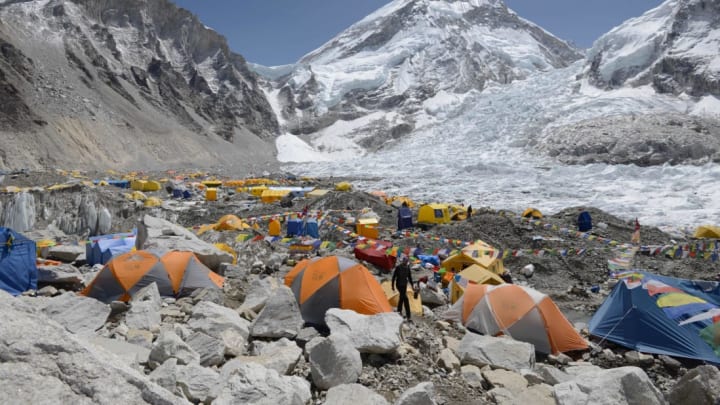On April 18, 2014, an avalanche killed 16 Sherpas on Mount Everest, making it the deadliest day in the mountain’s history. But one year later, a 7.8-magnitude earthquake triggered another fatal avalanche that killed more than 20 climbers and shut the mountain down for the 2015 season. During this year's season, at least 11 climbers have died on Everest experts say.
At 29,029 feet, Everest is known for its dangers; that's part of the allure. But in recent years, tragedies have spiked, and frozen bodies scattered across the mountain are an eerie reminder of the growing hazards. So why is the world’s tallest mountain claiming more lives than ever before?
1. Climate change makes Mount Everest unpredictable.
Everest tragedies are nothing new; since 1990, at least one climber has died in pursuit of the summit every year. But each climbing season, Everest is getting more unstable. Kent Clement, a professor of outdoor studies at Colorado Mountain College, argues that climate change is possibly the most imminent risk for climbers.
“As temperatures rise, Everest’s thousands of feet of ice and water are becoming unstable, making the mountain even more volatile,” Clement said.
Collapsing seracs—50- to 100-foot columns of ice formed by intersecting glacier crevasses—are a growing threat. Seracs can stand perfectly still for decades, then spontaneously fall over, killing those nearby and, in some cases, triggering avalanches further down the mountain. Case in point: The deadly 2014 avalanche that killed 16 Sherpas was caused by a serac collapse in the Khumbu Icefall, the most dangerous section of the route up Everest's southeastern face.
As you’d expect, climate-related risks are the new norm. A study in the journal The Cryosphere [PDF] predicts that Mount Everest’s glaciers could shrink by 70 percent this century, making currently unstable sections of the routes even more so.
2. Human biology is at odds with high altitudes on Mount Everest.

In addition to natural disasters, Everest climbers face a number of life-threatening health risks.
In high-altitude settings, there is less oxygen in the atmosphere, and oxygen doesn’t diffuse into a climber’s blood as well as it would at sea level. That can lead to serious medical problems. The two most common illnesses on Everest are high-altitude pulmonary edema (HAPE), in which constricted blood vessels cause fluid to leak into the lungs' air sacs; and high-altitude cerebral edema (HACE), in which fluid leaks from blood vessels in the brain, causing headaches, neurologic dysfunction, coma, and eventually death if not treated (and in some cases, even when treated).
“Altitude illness impacts people in different ways, and we don’t really know who is susceptible until they have altitude illness,” Christopher Van Tilburg, an expert in travel medicine and a physician Oregon's Providence Hood River Memorial Hospital, told Mental Floss. “High-altitude pulmonary edemas can hit people suddenly—even highly trained, fit mountaineers.”
3. Neurological and psychological factors can impair Everest climbers' judgment.
Another health risk that affects a climber’s cognition is hypoxia, which is simply when the brain doesn’t get enough oxygen. According to Clement, hypoxia can drastically impair judgment, making it one of the most dangerous Everest risks.
“The higher you climb, the more your judgment gets impaired,” Clement said. “It’s amazing how hard it is for smart people to do simple math and memory problems at high altitudes.”
In addition to causing treacherous missteps, hypoxia can drive climbers to push harder and go farther than they normally would—but not in a good way. These “cognitive traps” often happen when a climber gets closer to the top and replace logic and safety with stubborn determination, putting everything at risk to reach their goal. Another word for it? Summit fever.
According to Clement, the cure is setting a strict turnaround time: an ironclad moment when a climber promises to turn around and forego the summit to save their life. Turnaround times are decided before setting foot on Everest, and should be agreed upon between climbers, guides, and expedition leaders. But hypoxia, exposure, and inexperience can encourage climbers to ignore the protocol.
“Every time you ignore your turnaround time, you’re putting yourself at risk,” Clement said. “Professional guides are also supposed to follow these rules, but they get stuck in cognitive traps, too, because the more clients they get to the top, the more clients they’ll have next season.”
4. Medicine can reduce—but not eliminate—Mount Everest's dangers.
Any climb above 19,000 feet—the altitude known as “the death zone”—will have associated health risks, but there are treatments that can help climbers survive. Medicines include acetazolamide (sold under the brand name Diamox), a diuretic that helps prevent a mild edema, and dexamethasone (brand name Decadron), a steroid used to treat a brain edema and reverse the symptoms of acute mountain sickness. The only true fix for acute mountain sickness is immediate descent.
The best way to stay alive on Everest is proper training, fitness, and organization, but even those steps can't guarantee safety.
“Training doesn’t really offset objective hazards like rock falls, ice falls, avalanches, and earthquakes,” said Van Tilburg. “And while we have medicine for altitude illness to help people acclimatize, we don’t have medicines for the myriad other risks on Everest.”
